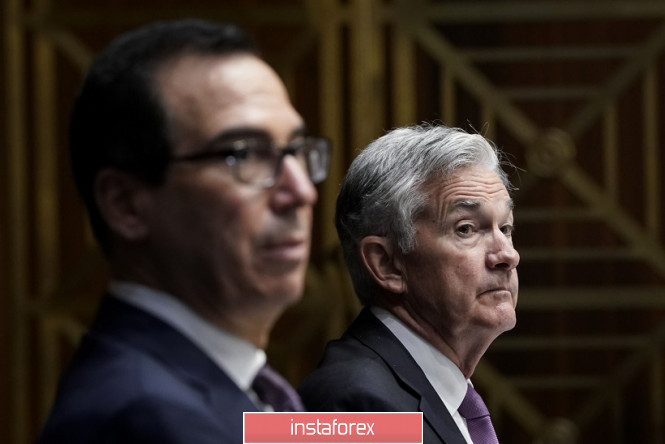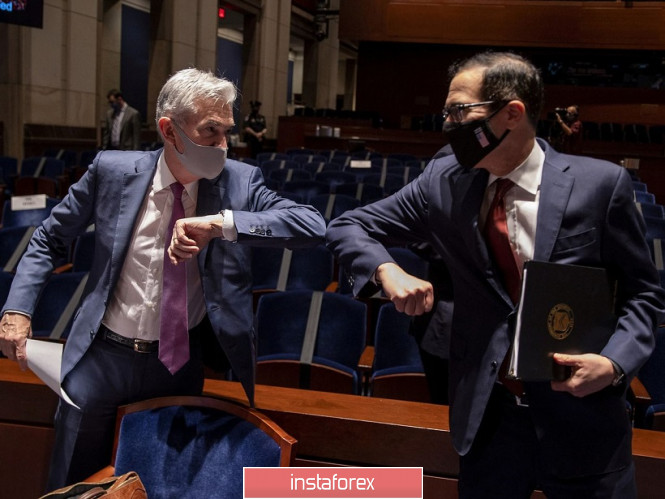There was a short-term corrective growth from the US currency yesterday. The dollar index showed positive dynamics for just a few hours, but declined again before the US session ended. The primary reason is the news about US Treasury Secretary, Mr. Steven Mnuchin, who demanded the Fed to return the unspent $ 455 billion from the COVID-19 fund. However, this factor was only a reason for the dollar's weakness, since in general, we have a negative fundamental background for the indicated currency, which does not contribute to its recovery.
Before discussing Mr. Mnuchin's statement yesterday, it is worth recalling that Mr. Trump lost the presidential election, so the ministerial composition of the White House will completely change in two months. The US Secretary, who influenced the currency market yesterday, will also leave his post. But at the same time, it's unlikely that his successor will consistently cancel all the decisions made during the previous administration. Moreover, some representatives of Democrats also agreed with Mnuchin's claims. It should also be noted that the Minister's demand is not verbal (emotional) in nature – this is the official position of the Department, which is issued in the form of an official appeal of the Ministry of Finance to the US Federal Reserve. Due to these issues, the dollar lost its position yesterday against the basket of major currencies. The market is talking about the fact that the Fed will soon resort to aggressive monetary easing again. At the same time, the head of the regulator, Mr. Powell, indirectly confirmed such intentions recently.

Now, let's go back to the US Treasury. We are talking about the funds that were allocated to the Fed as part of the first package to stimulate the US economy, which in turn, was approved by Congress back in March this year. The total amount of aid was $ 2 trillion 200 billion and $500 billion from which was allocated to the regulator for the creation of various emergency lending mechanisms through the Fed as well as loan guarantees. In the spring, that is, at the peak of the first wave of the pandemic, the measures taken helped to calm the markets. However, it turns out that the Fed has used only a small portion of the allocated funds. In view of this fact, Mr. Mnuchin officially asked to return the unused funds to the department – 429 billion of the remaining funds from the FRS and 26 billion of unused funds of direct loans from the Ministry of Finance.
It is noteworthy that J. Powell has already managed to refuse to do so, despite the fact that he avoids this kind of public argument most of the time. But in this case, the Fed's head said that the above program, which Mnuchin mentioned, ends only in a month and a half, that is, on the last day of the current year. Therefore, he would prefer that the entire volume of emergency funds continue to play its important role as a support for the vulnerable US economy. It should be noted that we are talking about the official response of the Central Bank, which was published on the official website of the Department. Such public conflicts between such structures are quite rare in the States.
Against this background, several experts from the US think that the current situation testifies, first of all, to the fact that the White House does not hope for a compromise on a new aid package for the US economy, and therefore is seeking alternative mechanisms for allocating funds. The alignment of political forces in the chambers of the US Congress after the elections remained the same: the House of Representatives is controlled by Democrats, while the Senate is by Republicans. Therefore, the negotiations, which lasted for six months, will continue.
Considering these prospects, the Fed may soon (at the December meeting) move from words to actions, softening the parameters of monetary policy. During the other day, Mr. Powell assured those present at a Bay Area Council event that the Fed would use all its tools to support the country's economy. He also called on Congress to pass a new fiscal stimulus package, but looking at the current political picture, we can assume that politicians are unlikely to compromise on this issue this year. By the way, two Fed representatives (James Bullard and John Williams) also came up with proposals to provide the economy with more stimulus last Wednesday.

This fundamental background broke the corrective growth of the US currency. Medical reports indicating new coronavirus anti-records in the United States served as a "control shot". So, over the past day, 185 thousand Americans were infected with the virus. A day earlier, this figure was at the level of 170 thousand. Since the beginning of November, this did not go below the 100-thousand mark, while demonstrating an upward trend. At the same time, US Vice President, Mike Pence said yesterday that the White House does not support the idea of introducing a nationwide quarantine. However, many States independently tighten restrictive measures up to a complete lockdown.
As a result, the current fundamental picture is not conducive to the dollar's recovery. The euro, in turn, looks more attractive against the dollar, despite a bunch of its own problems (COVID-19 and political tensions around the EU budget). All this suggests that long positions are still relevant for the EUR/USD pair with the first goal at 1.1940, which is the upper line of the Bollinger Bands indicator on the daily time frame.
The material has been provided by InstaForex Company - www.instaforex.com